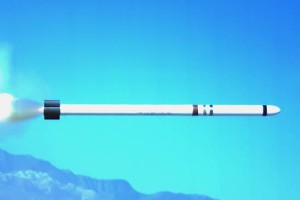Direct Hit in Moving Target Demonstration of the Semi-Active Laser Guided Zuni Rocket
 Westlake Village, California. MBDA Inc. announced the successful demonstration of a Semi-Active Laser Guided Zuni rocket against a moving target at the Navy’s test facilities at China Lake, CA. This firing comes after a successful shot against a static target in May of this year. The WGU-58/B Guidance and Control System developed in cooperation withthe Naval Air Warfare Center Weapons Division (NAWCWD)provides the Zuni 0weapon precision accuracy.
Westlake Village, California. MBDA Inc. announced the successful demonstration of a Semi-Active Laser Guided Zuni rocket against a moving target at the Navy’s test facilities at China Lake, CA. This firing comes after a successful shot against a static target in May of this year. The WGU-58/B Guidance and Control System developed in cooperation withthe Naval Air Warfare Center Weapons Division (NAWCWD)provides the Zuni 0weapon precision accuracy.
Jim Pennock, Vice President of Guided Rocket Sector Business Development at MBDA Inc. said “The WGU-58/B Guidance and Control system gives fixed wing aviators the ability to rapidly and accurately engage a moving target in close proximity to friendly forces. We are confident in the system’s ability to precisely engage moving targets and we demonstrated it today.”
The Zuni is fired from the LAU-10 launcher, which is a pod that is carried on a fighter aircraft’s weapon station. The pod is designed to carry and fire four Zuni rockets. This gives the aircraft an immediate increase in the number of targets that it can engage giving it more capability than comparable semi-active laser guided weapons which are limited to one or two per weapon station.
The high speed profile of the weapon will permit tactical aircraft using existing targeting pods to rapidly and accurately engage a target while staying outside the range of an enemy’s weapons. The WGU-58/B Guidance and Control system can provide an immediate precision guided weapon capability to any aircraft capable of carrying the LAU-10 pod.
MBDA’s industry team includes Elbit Systems of America, Fort Worth TX; General Dynamics, Healdsburg CA; and Honeywell, Minneapolis MN.
 Westlake Village, Californie. MBDA Inc a réalisé le premier tir de démonstration d’une roquette Zuni guidée par laser sur une cible en mouvement. Réalisé sur le polygone d’essai de l’US Navy à China Lake en Californie, ce tir fait suite au tir réussi en mai dernier d’une première roquette Zuni à guidage laser contre une cible fixe. Le kit de guidage WGU-58/B qui confère cette précision accrue à la roquette Zuni a été développé par MBDA Inc. en coopération avec la division armements du Naval Air Warfare Center.
Westlake Village, Californie. MBDA Inc a réalisé le premier tir de démonstration d’une roquette Zuni guidée par laser sur une cible en mouvement. Réalisé sur le polygone d’essai de l’US Navy à China Lake en Californie, ce tir fait suite au tir réussi en mai dernier d’une première roquette Zuni à guidage laser contre une cible fixe. Le kit de guidage WGU-58/B qui confère cette précision accrue à la roquette Zuni a été développé par MBDA Inc. en coopération avec la division armements du Naval Air Warfare Center.
Jim Penock, vice-président du développement dans le secteur des roquettes guidées chez MBDA Inc. déclare : «Le système de guidage WGU-58/B permettra aux pilotes d’avion de combat d’engager rapidement et avec précision une cible en mouvement, même à proximité des forces amies. Nous étions parfaitement confiants dans la capacité du système à engager avec précision des cibles en mouvement et nous l’avons à présent démontré. »
La roquette Zuni est tirée à partir d’un lanceur quadruple LAU-10, qui se présente comme une nacelle portée sur un point d’emport armement d’avion de combat. Cette solution multiplie immédiatement le nombre de cibles qu’un avion peut engager si on la compare aux autres types d’armes à guidage laser dont le nombre par point d’emport est limité à une ou deux.
La grande célérité de la munition permettra aux avions tactiques équipés de nacelles de désignation laser existantes d’engager rapidement et précisément leurs cibles tout en restant hors de portée d’un éventuel tir de riposte. Le kit de guidage WGU-58/B peut conférer immédiatement une capacité de tir de précision à n’importe quel avion susceptible d’emporter le lanceur LAU-10.
Pour mener à bien ce développement, MBDA a rassemblé autour d’elle une équipe industrielle composée de : Elbit Systems of America, Fort Worth Texas, General Dynamics, Healdsburg Californie, et Honeywell, Minneapolis Minnesota.
 Westlake Village, California. MBDA Inc. ha annunciato la riuscita di un test effettuato da un razzo Zuni guidato con la funzionalità SAL (Semi-Active Laser) tenutasi presso gli impianti di collaudo della marina militare statunitense a China Lake, in California. Questa dimostrazione è stata effettuata dopo un tiro di prova contro un bersaglio statico, eseguito con successo nel mese di maggio di questo anno. Il sistema di guida e controllo WGU-58/B, sviluppato in cooperazione con la NAWCWD (Naval Air Warfare Center Weapons Division), fornisce la precisione dello Zuni.
Westlake Village, California. MBDA Inc. ha annunciato la riuscita di un test effettuato da un razzo Zuni guidato con la funzionalità SAL (Semi-Active Laser) tenutasi presso gli impianti di collaudo della marina militare statunitense a China Lake, in California. Questa dimostrazione è stata effettuata dopo un tiro di prova contro un bersaglio statico, eseguito con successo nel mese di maggio di questo anno. Il sistema di guida e controllo WGU-58/B, sviluppato in cooperazione con la NAWCWD (Naval Air Warfare Center Weapons Division), fornisce la precisione dello Zuni.
Jim Pennock, Vice Presidente del reparto Guided Rocket Sector Business Development presso MBDA Inc. ha affermato che “Il sistema di guida e controllo WGU-58/B offre ai piloti di aeromobili ad ala fissa la possibilità di agganciare in modo rapido e preciso un bersaglio mobile in prossimità di forze amiche. Oggi abbiamo dimostrato la straordinaria capacità del sistema di colpire i bersagli mobili senza margine di errore”.
Il lancio dello Zuni è stato effettuato tramite il lanciatore LAU-10, un pod che viene posizionato sulla stazione missilistica di un caccia da combattimento. Il pod è progettato per il trasporto e il lancio di quattro razzi Zuni e garantisce all’aeromobile, in confronto alle armi guidate da laser semiattivi, un maggior numero di bersagli attaccabili. Le armi a guida semiattiva, infatti hanno un’efficacia limitata ad uno o due bersagli per ciascuna stazione d’armi.
Il profilo ad elevata velocità dell’arma permetterà agli aeromobili tattici che utilizzano il pod esistenti, di attaccare rapidamente e con precisione i bersagli, rimanendo al di fuori del raggio d’azione delle armi nemiche. Il sistema di guida e controllo WGU-58/B fornisce un’arma guidata di precisione immediata a qualsiasi aeromobile in grado di trasportare il pod LAU-10.
Il team di settore di MBDA include Elbit Systems of America, Fort Worth TX; General Dynamics, Healdsburg CA e Honeywell, Minneapolis MN.



